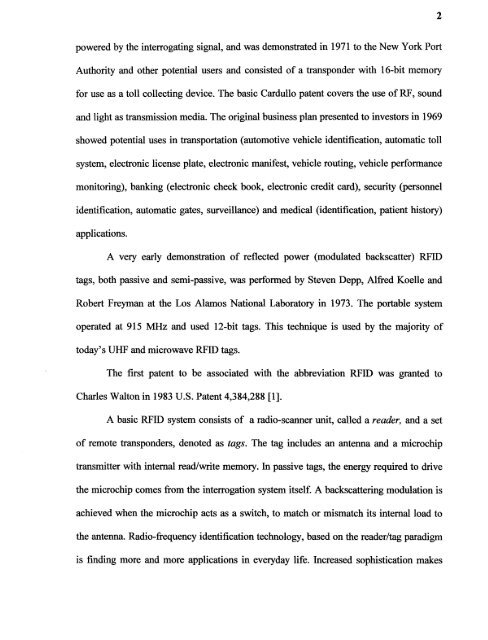Non-foster matching of an RFID antenna - New Jersey Institute of ...
Non-foster matching of an RFID antenna - New Jersey Institute of ...
Non-foster matching of an RFID antenna - New Jersey Institute of ...
Create successful ePaper yourself
Turn your PDF publications into a flip-book with our unique Google optimized e-Paper software.
2<br />
powered by the interrogating signal, <strong>an</strong>d was demonstrated in 1971 to the <strong>New</strong> York Port<br />
Authority <strong>an</strong>d other potential users <strong>an</strong>d consisted <strong>of</strong> a tr<strong>an</strong>sponder with 16-bit memory<br />
for use as a toll collecting device. The basic Cardullo patent covers the use <strong>of</strong> RF, sound<br />
<strong>an</strong>d light as tr<strong>an</strong>smission media. The original business pl<strong>an</strong> presented to investors in 1969<br />
showed potential uses in tr<strong>an</strong>sportation (automotive vehicle identification, automatic toll<br />
system, electronic license plate, electronic m<strong>an</strong>ifest, vehicle routing, vehicle perform<strong>an</strong>ce<br />
monitoring), b<strong>an</strong>king (electronic check book, electronic credit card), security (personnel<br />
identification, automatic gates, surveill<strong>an</strong>ce) <strong>an</strong>d medical (identification, patient history)<br />
applications.<br />
A very early demonstration <strong>of</strong> reflected power (modulated backscatter) <strong>RFID</strong><br />
tags, both passive <strong>an</strong>d semi-passive, was performed by Steven Depp, Alfred Koelle <strong>an</strong>d<br />
Robert Freym<strong>an</strong> at the Los Alamos National Laboratory in 1973. The portable system<br />
operated at 915 MHz <strong>an</strong>d used 12-bit tags. This technique is used by the majority <strong>of</strong><br />
today's UHF <strong>an</strong>d microwave <strong>RFID</strong> tags.<br />
The first patent to be associated with the abbreviation <strong>RFID</strong> was gr<strong>an</strong>ted to<br />
Charles Walton in 1983 U.S. Patent 4,384,288 [1].<br />
A basic <strong>RFID</strong> system consists <strong>of</strong> a radio-sc<strong>an</strong>ner unit, called a reader, <strong>an</strong>d a set<br />
<strong>of</strong> remote tr<strong>an</strong>sponders, denoted as tags. The tag includes <strong>an</strong> <strong>an</strong>tenna <strong>an</strong>d a microchip<br />
tr<strong>an</strong>smitter with internal read/write memory. In passive tags, the energy required to drive<br />
the microchip comes from the interrogation system itself. A backscattering modulation is<br />
achieved when the microchip acts as a switch, to match or mismatch its internal load to<br />
the <strong>an</strong>tenna. Radio-frequency identification technology, based on the reader/tag paradigm<br />
is finding more <strong>an</strong>d more applications in everyday life. Increased sophistication makes
















